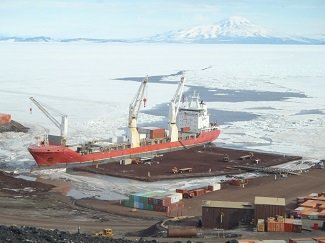Ocean Disposal of Man-Made Ice Piers
In 2021, the EPA re-issued a general permit under the Marine Protection, Research and Sanctuaries Act (MPRSA) authorizing the National Science Foundation (NSF) to dispose of man-made ice piers in ocean waters from its station at McMurdo Sound in Antarctica. The general permit was published in the Federal Register notice of December 7, 2021 and is effective as of January 6, 2022 [86 FR 69242].
What is an ice pier and how is it disposed in the ocean?

The NSF is responsible for oversight of the United States Antarctic Program (USAP). McMurdo Station, the logistics hub of the USAP, receives personnel and supplies destined for locations in Antarctica via ships docked at the McMurdo Station man-made ice pier.
Man-made ice piers are constructed with steel cable, mesh, pipe, bollards and wooden poles embedded in a man-made sheet of ice.
A typical ice pier at the McMurdo Station measures 550 feet (168 meters) long, 250 feet (76 meters) wide, 20 feet (6 meters) thick, and is covered by gravel to provide a non-slip working surface. An ice pier has a normal life span of one to ten years.
At the end of an ice pier’s effective life, the wooden poles, bollards, and steel pipes are severed just above the surface of the ice, the gravel is removed to the extent possible, and all transportable equipment, materials, and debris are removed. The pier is then towed into the McMurdo Sound for disposal or, when towing is not feasible, cast loose from the shore and allowed to float into the sound. The pier then floats freely within the ice pack, where the pier eventually disintegrates as the ice melts. The materials disposed in the ocean under this general permit (other than ice, which melts naturally) include the construction materials that cannot be removed prior to disposal.
What are the effects of the disposal of ice piers on the ocean?
The EPA, after consultation with the National Oceanic and Atmospheric Administration and the Department of the Interior, determined that the disposal of man-made ice piers poses a very minimal adverse risk to the marine environment and represents small quantities of unrecoverable non-ice materials.
To further protect the Antarctic environment, the MPRSA permit conditions require the NSF: to implement a spill prevention, control and countermeasure plan; to report annually any spill or discharge as well as any clean-up procedures; and to track released ice piers for as long as the embedded tracking device remains functional to allow the NSF and the EPA to confirm the fate of materials used in the ice pier construction.
To learn more about the ice piers, please visit the NSF’s McMurdo Station website.
